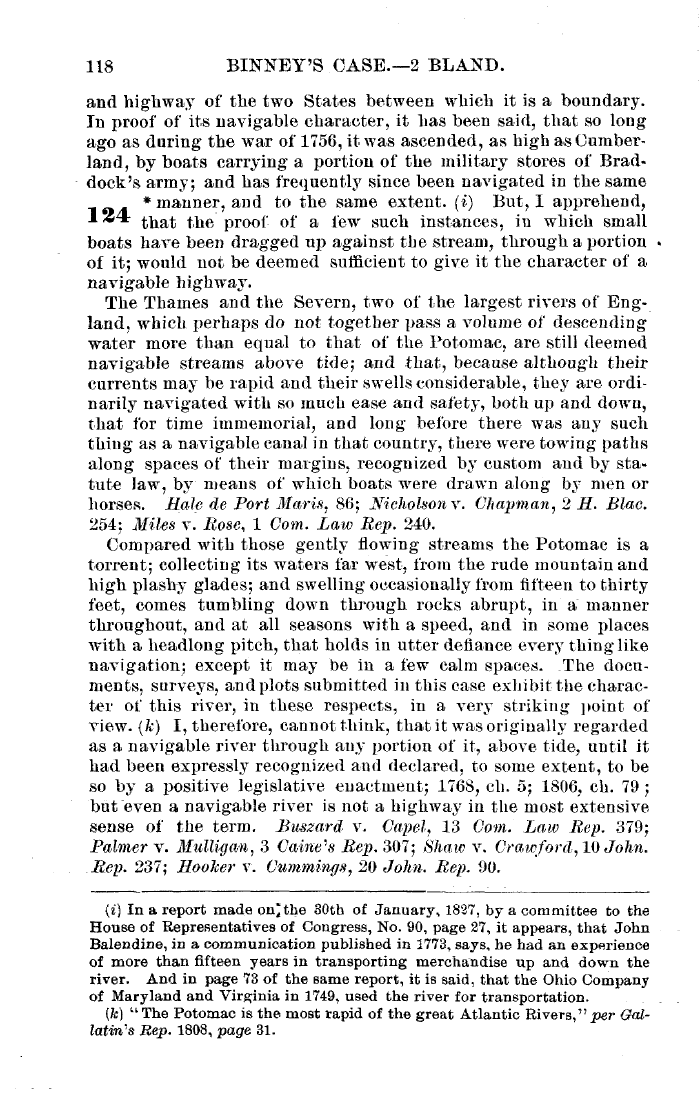|
118 BINNEY'S CASE.-2 BLAND.
and highway of the two States between which it is a boundary.
In proof of its navigable character, it has been said, that so long
ago as during the war of 1756, it was ascended, as high as Cumber-
land, by boats carrying a portion of the military stores of Brad-
dock's army; and has frequently since been navigated in the same
* manner, and to the. same extent. (i) But, I apprehend,
1 24 that the proof of a few such instances, in which small
boats have been dragged up against the stream, through a portion
of it; would not be deemed sufficient to give it the character of a
navigable highway.
The Thames and the Severn, two of the largest rivers of Eng-
land, which perhaps do not together pass a volume of descending
water more than equal to that. of the Potomac, are still deemed
navigable streams above tide; and .that, because although their
currents may be rapid and their swells considerable, they are ordi-
narily navigated with so much ease and safety, both up and down,
that for time immemorial, and long before there was any such
thing as a navigable canal in that country, there were towing paths
along spaces of their margins, recognized by custom and by sta.
tute law, by means of which boats were drawn along by men or
horses. Hale, de Port 3Taris, 86; Nicholson v. Chapman, 2 H. Blac.
254; Miles v . Rose, 1 Com. Law Rep. 240.
Compared with those gently flowing streams the Potomac is a
torrent; collecting its waters far west, from the rude mountain and
high plashy glades; and swelling occasionally from fifteen to thirty
feet, comes tumbling down through rocks abrupt, in a manner
throughout, and at all seasons with a speed, and in some places
with a headlong pitch, that holds in utter defiance every thing like
navigation; except it may be in a few calm spaces. The docu-
ments, surveys, and plots submitted in this case exhibit the charac-
ter of this river, in these respects, in a very striking point of
view. {k) I, therefore, cannot think, that it was originally regarded
as a navigable river through any portion of it, above tide, until it
had been expressly recognized and declared, to some extent, to be
so by a positive legislative enactment; 1768, ch. 5; 1806, ch. 79 ;
but-even a navigable river is not a highway in the most extensive
sense of the term. IBuszard v. Capel, 13 Cons. Law Rep. 379;
Palmer v. Mulligan, 3 Caine's Rep. 307; Shaw v. Crawford,10 John.
Rep. 237; Hooker v. Cwmminr~s, 20 John. Rep. 90.
~i) In a report made on; the 30th of January, 1827, by a committee to the
House of Representatives of Congress, No. 90, page 27, it appears, that John
Balendine, in a communication published in 1773, says, be had an experience
of more than fifteen years in transporting merchandise up and down the
river. And in page 73 of the same report, it is said, that the Ohio Company
of Maryland and Virginia in 1749, used the river for transportation.
(k) "The Potomac is the most rapid of the great Atlantic Rivers," per Gal-
latin's Rep. 1808, page 31.
|

